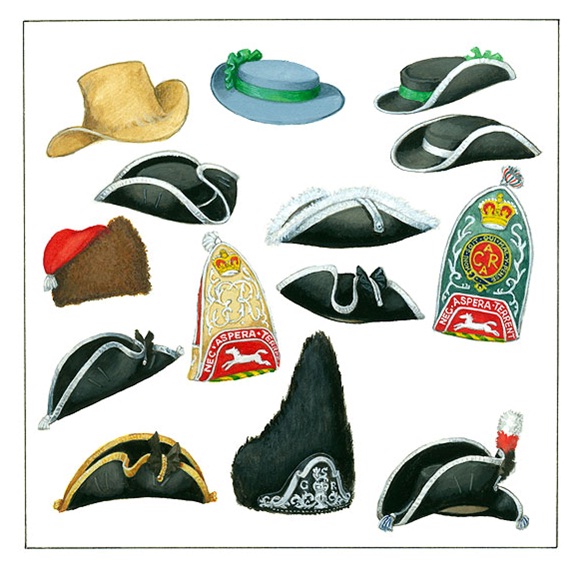- 17th and 18th Centuries
- 19th Century. First Half
- 19th Century. Second Half
- 20th Century
Headress History
17th and 18th Centuries
Much thought and accumulated experience have gone into the matters of production of suitable headgear both from the points of view of decoration and protection.

17th and 18th Centuries
Top row: Hats 1666, 1670/84, 1695, 1700. Second row: Three cornered hat for private soldier and an officer. Third row: Grenadier caps 1685, 1742, three cornered hat private soldier, grenadier cap 1751. Fourth row: Three cornered hat 1768, light infantry cap 1782. Bottom row: Bi-cornered hat 1782, grenadier cap 1768, bi-cornered hat 1795.
From the time of Cromwell’s New Model Army of 1645 broad brimmed Flemish hats were introduced to the soldiery and were worn with a metal skull cap sewn inside the crown for physical protection. After the restoration of the Monarchy there was an intermediate step of the famous Monmouth Cap, a broad-brimmed, low crowned felt hat. One side of the brim was generally turned up. Then came the tall Flemish hat was developed into the low crowned Carolina hat of felt bedecked with tape edging and ribbons. For ease when performing musket drill one side of the hat was looped up but as this did not look very tidy the other side was soon looped up as well. This in turn led to the development of the three-cornered hat.
Officers in Marlborough’s Army wore full bottom wigs liberally curled and long enough to reach the shoulders whilst the men cut their hair short. By George II’s reign officers’ wigs had become smaller and were tied back with black silk ribbons. They were decorated with powder. Themen’s hair, now worn long and tied in a queue, was smeared with tallow or lard and powdered with flour. Men who carefully prepared their hair on nights before a special parade were known to sleep face downwards to avoid disturbing it before morning. The queue was worn in a bag, secured with black ribbons tied according to a regimental pattern. This kept much off the red coat.The grenadier cap was introduced in James II’s time as the wide brimmed hat interfered with the throwing of grenades. The first version of this headdress resembled a stocking cap and was decorated with fur and a tassel. Gradually this developed into a mitre shape with regimental devices on the front. Officers’ caps were beautifully embroidered in coloured silks and many examples still survive.
By the end of the eighteenth century hair powder was being phased out and by the time of the Napoleonic wars queues were abolished by a War Office Order of 1808. The Royal Welch Fusiliers were the last Regiment to lose them, thereafter wearing a flash of black ribbons on the backs of their collars as souvenirs.
Copyright 2014 Linkorient.com. All Rights Reserved





 ++84 (0) 912.278.988
++84 (0) 912.278.988
